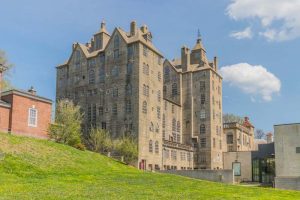
Around an historic area like Princeton, there are many relics of the past worthy of saving, witnessing and celebrating. Many are stored in museums to last well into the future. While we could spend days talking about the numerous museums located just in Princeton and Mercer County (and we do discuss some in other articles of this issue!), we want to highlight one located just across the river in Bucks County.
Mercer Museum and Fonthill Castle, located in Doylestown, PA, are visited by a combined 95,000+ visitors each year. All come to see, touch and learn from over a century of history initiated by Henry Chapman Mercer in the early 1900s, as well as even more from Bucks County archives.
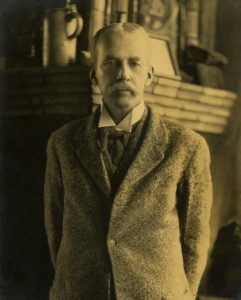 Mercer (of no relation and not to be confused with General Hugh Mercer, the namesake for Mercer County, NJ) was ahead of his time. Most well known as a tile designer, he was also an historian, amateur architect, collector and curator. Whereas many people keep things in our homes that one day could be perceived as precious or unique, Mercer took collections and his talents one step further. He built himself a castle-style home, Fonthill Castle, and nearby decided to then build Mercer Museum, also inspired by castle architecture. In it, he stored a collection of almost 30,000 objects; most that were still being used in his day but which he saw as becoming either obsolete or an important mark of their time. It includes everyday items like spoons or bicycles as well as pre-industrial items such as a hand-pumped fire engine.
Mercer (of no relation and not to be confused with General Hugh Mercer, the namesake for Mercer County, NJ) was ahead of his time. Most well known as a tile designer, he was also an historian, amateur architect, collector and curator. Whereas many people keep things in our homes that one day could be perceived as precious or unique, Mercer took collections and his talents one step further. He built himself a castle-style home, Fonthill Castle, and nearby decided to then build Mercer Museum, also inspired by castle architecture. In it, he stored a collection of almost 30,000 objects; most that were still being used in his day but which he saw as becoming either obsolete or an important mark of their time. It includes everyday items like spoons or bicycles as well as pre-industrial items such as a hand-pumped fire engine.
“He definitely recognized these things would one day be considered historic or rare and he wanted to make sure the significance of these items would be recognized,” explains Annie Halliday, Director of Library and Archives at Mercer Museum and Fonthill Castle. “It’s not a typical museum experience. You can read labels, we have interpretations, but if you’re not a conventional museum person you can still walk in and be blown away with how quirky and interesting the buildings are. There’s strong aesthetics throughout both buildings, which makes us appealing to a broader audience.”
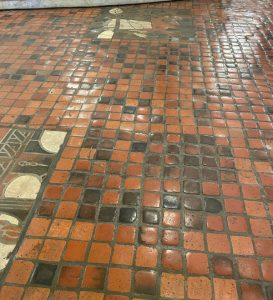 Mercer himself was not just a quiet collector. He was part of the arts and crafts movement and the designer of such notables as the tile floor mosaic installation in the Capitol building in Harrisburg, PA today. Featured in magazines about cement or the arts & crafts movement, Mercer not only traveled to collect oral histories but was known to research and find local histories as well.
Mercer himself was not just a quiet collector. He was part of the arts and crafts movement and the designer of such notables as the tile floor mosaic installation in the Capitol building in Harrisburg, PA today. Featured in magazines about cement or the arts & crafts movement, Mercer not only traveled to collect oral histories but was known to research and find local histories as well.
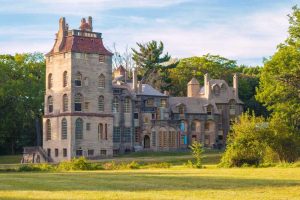
Visitors today can enter what was once the private residence of Mercer, Fonthill Castle, which is still very much the same as in his day. When he passed in 1930, Mercer left it to his housekeeper (and her husband), and she lived there until her death in the 1970s. The home was then put into a trust and ultimately into the hands of the Bucks County Historical Society. Using photographs and other inventories, it was slowly restored it to its original glory. Mercer himself was a founding member of the society in 1880, so it is great continuity for it to now be in under their control.
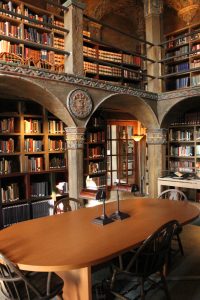
The Bucks County Historical Society today operates both Fonthill Castle and Mercer Museum. It has a collection of more than 40,000 objects, some obtained through original accession or things Mercer purchased, as well as donations and purchases made over time. The museum’s on-site Research Library also houses over 20,000 books, 12,000 images, maps, periodicals and pamphlets, 2,500 feet of county government archives, early technology items and more.
“We have a broad yet specific scope. We are Bucks County Historical Society, so we collect for Bucks County History which is great for Bucks County genealogy or historic property or an historical event or something you’re just interested in,” Halliday shares. “Since we’re also connected to the tools and trade part, we have ledgers from blacksmiths, organizational records related to lumber yards or businesses in Doylestown creating things. We have Mercer’s papers, his architectural notebooks, tile drawings, research from his time at Harvard. It encapsulates his life’s work. We do also have some things just related to the arts and crafts movement or tile making in general.”
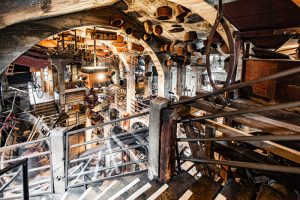
The facility and ability to store so many sensitive materials makes Mercer Museum unique as a county deposit. Blacksmiths will come up from Colonial Williamsburg and they’ll interact with items to learn new methods, and researchers come to find collections of things that are difficult to find anywhere else, like butter molds. People come on their own to research about the time of their grandparents or schools will come on field trips to learn about pre-industrial technology.
“I doubt Mercer could’ve imagined the world we live in today, and things he’d have considered to be mundane are remarkable to us. We have a card catalog when you enter the research library, and children have no idea what that is. They think its historical! [but it’s actually being used!] We have a huge, long well sweep and wooden water pipes, things you can’t fathom using today. We have a huge impact in reminding kids and adults alike of where we came from technology-wise and how things have changed,” Halliday adds.
 Jeff Marshall is a Bucks County local and former President of Heritage Conservancy, who has been researching the area’s historic buildings since 1977 and now visits the museum’s Research Library nearly weekly.
Jeff Marshall is a Bucks County local and former President of Heritage Conservancy, who has been researching the area’s historic buildings since 1977 and now visits the museum’s Research Library nearly weekly.
“In my early years I spent countless hours trying to learn about historic buildings by finding documents such as wills and associated inventories, Orphans Court documents, land drafts and local newspapers beyond what was needed to complete projects. This was generally used to try to provide baseline documentation to supplement architectural evaluations of structures to accurately tell the story of a historic building,” Marshall details.
And stories he has found. Through his research, Marshall has made some unique and interesting discoveries.
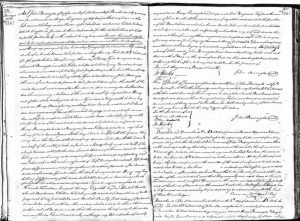 “One thing I found was in the will of John Burroughs giving his one son Samuel one silver dollar ‘because by his imprudent conduct he caused his father to spend more money than his share of the property would amount to’. That got me digging and I found out that Samuel was a Tory and a horse thief who was vilified by the Revolutionary leaders of Bucks County and his father got him off relatively unscathed. Deeper research showed that he obtained a character reference from a Virginia officer who had apparently spent time in the family’s house around the time of Washington’s Crossing and is one of the only references to where troops beyond the generals were encamped.”
“One thing I found was in the will of John Burroughs giving his one son Samuel one silver dollar ‘because by his imprudent conduct he caused his father to spend more money than his share of the property would amount to’. That got me digging and I found out that Samuel was a Tory and a horse thief who was vilified by the Revolutionary leaders of Bucks County and his father got him off relatively unscathed. Deeper research showed that he obtained a character reference from a Virginia officer who had apparently spent time in the family’s house around the time of Washington’s Crossing and is one of the only references to where troops beyond the generals were encamped.”
With historical materials dating back to the 1680s as part of the Bucks County government collections and those gathered by Mercer himself since the 1880s, there is a lot to learn and locate. Deeds once signed by William Penn, a register of slaves from 1783 and even a book that describes how properties were marked are preserved.
“We have an Earmark book filled with drawings of cattle ears, and all the different marks to designate what cattle was owned by each farmer. Nicks they’d cut out of a cow’s ear. It is one of first records of Bucks County,” Halliday exclaims.
Thanks to a priority that materialized from COVID, the photograph collection of the museum is fully digitized and 90% of the postcard collection is as well. If you can’t make it on site, there is an online database accessible to anyone. If an item has not been digitized, sometimes a photo is attached to the record so that you can still catch a glimpse. And if you find something of interest, they offer a collection access visit where the item is pulled from the museum or storage for you to come and see in person.
“We’re very proud of our collection, and many people don’t know there is a library associated with the museum,” Halliday boasts. “Our favorite types of people are those that just want to see cool stuff.”
If you like cool stuff, whether you want to tour Mercer’s old home, be inspired by the collections within the museum or research an old plot of land that was once in your family, there is a lot of history available.
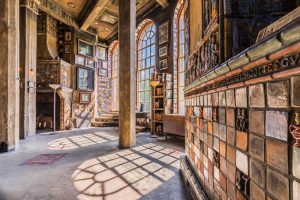
Mercer Museum and Fonthill Castle each require a separate ticket but are both open Tuesdays through Sundays. Fonthill Castle, a National Historic Landmark, provides 60-minute guided tours only. The museum, a Smithsonian affiliate, offers self-guided tours with timed tickets. The Research Library entry is open Tuesdays through Saturdays, and entry is free with a Mercer Museum ticket or to members of Bucks County Historical Society.
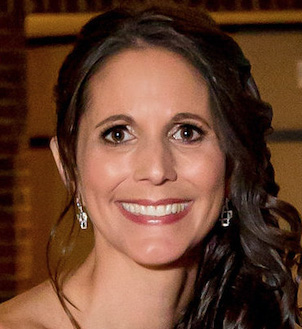
Lisa Jacknow spent years working in national and local news in and around New York City before moving to Princeton. Working as both a TV producer and news reporter, Lisa came to this area to focus on the local news of Mercer County at WZBN-TV. In recent years, she got immersed in the Princeton community by serving leadership roles at local schools in addition to volunteering for other local non-profits. In her free time, Lisa loves to spend time with her family, play tennis, sing and play the piano. A graduate of the S. I. Newhouse School of Public Communications at Syracuse University, Lisa was raised just north of Boston, Massachusetts but has lived in the tri-state area since college. She is excited to be Editor and head writer for Princeton Perspectives!
